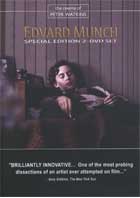
Edvard Munch (Special Edition 2-DVD set) 2007
Distributed by Project X Distribution Limited, 223 Humberside Ave., Toronto, Ontario M6P 1K9, Canada; 416-604-2506
Produced by Peter Watkins
Directed by Peter Watkins
DVD, color, 220 min.
College - Adult
Film Studies, Media Studies, Art History, Biography
Date Entered: 10/15/2008
Reviewed by Oksana Dykyj, Head, Visual Media Resources, Concordia University, MontrealIn 1973 Peter Watkins made a 110- minute film about the Norwegian artist Edvard Munch in which he employed filmic devices such as flashback, fractured sound and a psychological separation of space and time emulating Munch’s state of mind. The jigsaw puzzle is then assembled by the viewer to form a personal portrait of the life of the artist and the historical context around it. This new 2-DVD set includes a new high-definition video transfer, 6 minutes of 9.5mm amateur film footage shot by Edvard Munch himself in 1927, 3 short documentaries from the late 1950s and early 60s, as well as a 56-page booklet that contains one of Peter Watkins’ self-interviews from 2005. Because Watkins believes that his work is marginalized, he no longer gives interviews but supplies researchers and journalists with prepared texts answering most any question he feels might be asked. His position on his marginalization and his analysis of what he terms “the media crisis” can be found on his website. As it relates to this film Watkins asks, “What is not political in a work of art – especially one using as powerful means of communication as the cinema or TV?” In challenging the reactionary society of his time Munch can be seen as taking a political stance. The film itself investigates popular culture’s relationship to art and history and stresses its complexity.
The density of the narrative structure coupled with the use of non-actors implicates the viewer further from simply experiencing to a participation in the act of codifying art and sociological history. The voice-over narration creates a traditional documentary envelope while the fragmented depiction of the life mirrors Munch’s own diaries. The outcome is a unique and powerful moving image document about an artist in the early 20th century. Highly recommended for academic areas of film and media studies as well as art history.